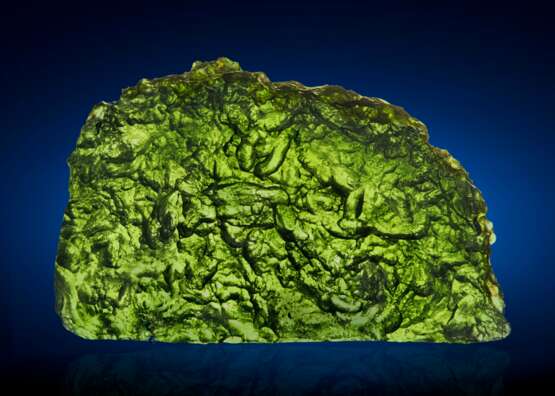ID 491247
Lot 37 | MOLDAVITE — GLASS CREATED WHEN EARTH AND ASTEROID COLLIDE
Estimate value
$ 2 000 – 3 000
Tektites are terrestrial in origin and are named after the locality in which they are found. Hence, there are philippinites, australites and moldavites — indisputably the most beautiful of all. A tektite’s shape is the product of a host of variables including the altitude reached by molten material splashed into the sky, the subsequent ablation experienced as it falls back to Earth, as well as its orientation and speed of rotation during descent. The surface detail seen is largely the result of the acidity of the soil in which the glass was entombed for millions of years.
Moldavites formed nearly 15 million years ago as a result of the asteroid impact that created the 23 km diameter Nördlinger-Ries crater near Stuttgart, Germany — and are found in the Moldau River Valley in the Czech Republic nearly 450 km away from the site of impact. Revered as a talisman by Paleolithic humans and delivered by men to their fiancées in the 17th-19th centuries to ensure marital harmony, moldavites are often cut into gemstones. Prized for their clarity, shape and color, and alleged metaphysical properties, moldavites vary remarkably in texture; a moldavite found on a hill can look very different from one found in an adjacent valley.
Now offered is a highly crenellated, poison green, moldavite disk from the prized location of Nová Hospoda in the Czech Republic. Crenellations abound and the rich hues, which range from emerald to tourmaline, result from variations of density.
Christie's would like to thank Dr. Alan E. Rubin at the Department of Earth, Planetary, and Space Sciences, University of California, Los Angeles for his assistance in preparing this catalogue.
34 x 55 x 10mm (1.3 x 2 x 0.33 in.) and 36.22g (181 carats)
| Address of auction |
CHRISTIE'S 20 Rockefeller Plaza 10020 New York USA | ||||||||||||||
|---|---|---|---|---|---|---|---|---|---|---|---|---|---|---|---|
| Preview |
| ||||||||||||||
| Phone | +1 212 636 2000 | ||||||||||||||
| Fax | +1 212 636 4930 | ||||||||||||||
| Conditions of purchase | Conditions of purchase | ||||||||||||||
| Shipping |
Postal service Courier service pickup by yourself | ||||||||||||||
| Payment methods |
Wire Transfer | ||||||||||||||
| Business hours | Business hours
|



